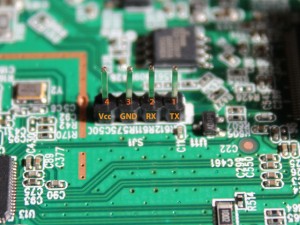The TP-LINK router TL-MR3220 is a very cheap (around €22 in Germany) yet feature-rich wireless 802.11n router that supports the open source OpenWRT firmware. It offers a USB port, allowing a bunch of additional peripheral hardware to be connected. Installing the matching OpenWRT nightly build was easy enough, the original firmware offers to do so using the standard web interface.
I was thinking about connecting one of them to an Arduino in a project to come. The integrated serial interface seems to be the obvious way to achieve this. The router’s board readily exposes the interface, so I added a 4-pin header to do a few tests. The pin-out of the interface is documented in the OpenWRT wiki. Using a standard FTDI adapter I then got access to the router’s serial console. From here it should not be to hard to use the same interface to connect to an Arduino instead.









Pingback: Serial Communication Between an Arduino and the TL-MR3220 Router | hackup.net
Very cool. Great to know I can install OpenWRT on such a cheap router. I want to turn it into a PirateBox.
Do you use it as Wlan-Client? I have massive problems with the wlan-configuration, especially to let it run in sta-mode. Some hints would be higly appreciated (gerne auch in Deutsch & per Mail 😉 )
best regards,
-mud-
@Mudhenn: Yes, I’ve configured the router as a wifi client and it works without problems for me. I have not tried to configure it as a base station, though. I could send you my configuration for client mode, but I doubt it would help you with sta-mode…
Installed openwrt without problems, but quite ignorant about the best way to make it work as a (wireless) client in my lan (with another router). Can you send your configurations? Thanks.
Actually, I installed the lucy web GUI on my router and used it to configure the wifi setup. Using the GUI makes this task close to trivial.